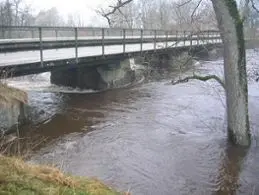Flows and tides
Bridges and road culverts are subjected to considerable stresses during extreme flow events. Our calculations can be used as a basis for dimensioning and impact assessments and can even show the impacts of a changing climate.


In order to facilitate the planning of constructions in water, it is important to look at both statistics and future predictions.
We can supply information, with the help of both historical data and future climate scenarios, to comply with safety requirements.
A large variety of services
- Calculation of the rate of flow in waterways, for example when extending sections of roads and bridges
- Calculation of water levels at high and low tide, and in the event of extreme flows
- Assessment of future water levels and rates of flow according to climate scenarios
- Statistical analyses of historical data
- Documentation for environmental impact assessments
The results are presented in an easily comprehensible report where a large number of flow levels with varying return periods are presented, according to your requirements.
Consider a changing climate
The climate research at Rossby Centre indicates that we are heading for a warmer climate with more precipitation, and studies have shown that these tendencies can be seen already.
Traditional calculations for constructing in water are based on statistical analyses of long hydrological series. They do not take into consideration that the temperature and precipitation patterns change in a future climate.
For buildings and constructions with an expected life time of more than 100 years or longer, it is important to consider their sensitivity for climatic changes.
Climate-adapted design flows
By using several regional climate scenarios together with hydrological modeling, we can produce a variety of hydrological scenarios. Frequency analysis provides an idea regarding how climate scenarios affect the outcome of the traditional dimensioning documentation
- Highest High Tide with a return time of 100 years (HHQ 100) - based on historic data
- Evaluation of future levels for mean annual river flow (MQ) and highest high tide (HHQ 100) - specified as a percentage of today's levels (e.g for the period 2070-2100)
